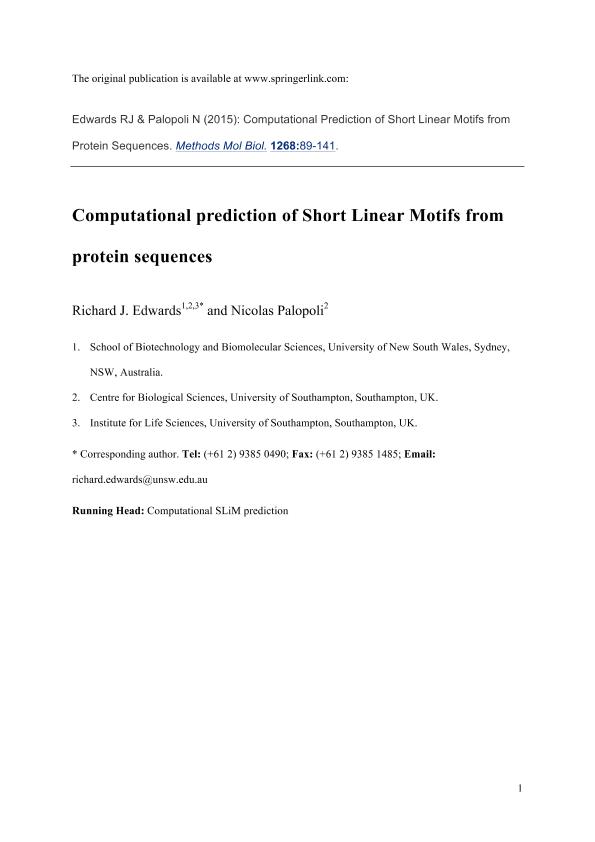Mostrar el registro sencillo del ítem
dc.contributor.author
Edwards, Richard J.
dc.contributor.author
Palopoli, Nicolás

dc.date.available
2019-10-07T18:53:07Z
dc.date.issued
2015-01
dc.identifier.citation
Edwards, Richard J.; Palopoli, Nicolás; Computational prediction of short linear motifs from protein sequences; Springer; Methods in molecular biology (Clifton, N.J.); 1268; 1-2015; 89-141
dc.identifier.issn
1940-6029
dc.identifier.uri
http://hdl.handle.net/11336/85303
dc.description.abstract
Short Linear Motifs (SLiMs) are functional protein microdomains that typically mediate interactions between a short linear region in one protein and a globular domain in another. SLiMs usually occur in structurally disordered regions and mediate low affinity interactions. Most SLiMs are 3-15 amino acids in length and have 2-5 defined positions, making them highly likely to occur by chance and extremely difficult to identify. Nevertheless, our knowledge of SLiMs and capacity to predict them from protein sequence data using computational methods has advanced dramatically over the past decade. By considering the biological, structural, and evolutionary context of SLiM occurrences, it is possible to differentiate functional instances from chance matches in many cases and to identify new regions of proteins that have the features consistent with a SLiM-mediated interaction. Their simplicity also makes SLiMs evolutionarily labile and prone to independent origins on different sequence backgrounds through convergent evolution, which can be exploited for predicting novel SLiMs in proteins that share a function or interaction partner. In this review, we explore our current knowledge of SLiMs and how it can be applied to the task of predicting them computationally from protein sequences. Rather than focusing on specific SLiM prediction tools, we provide an overview of the methods available and concentrate on principles that should continue to be paramount even in the light of future developments. We consider the relative merits of using regular expressions or profiles for SLiM discovery and discuss the main considerations for both predicting new instances of known SLiMs, and de novo prediction of novel SLiMs. In particular, we highlight the importance of correctly modelling evolutionary relationships and the probability of false positive predictions.
dc.format
application/pdf
dc.language.iso
eng
dc.publisher
Springer

dc.rights
info:eu-repo/semantics/openAccess
dc.rights.uri
https://creativecommons.org/licenses/by-nc-sa/2.5/ar/
dc.subject
Short linear motifs
dc.subject
SLIM
dc.subject
Motif discovery
dc.subject
Protein-protein interactions
dc.subject
Posttranslational modifications
dc.subject
Intrinsically disordered proteins
dc.subject
Regular expressions
dc.subject
Sequence profiles
dc.subject
Sequence motifs
dc.subject.classification
Ciencias de la Información y Bioinformática

dc.subject.classification
Ciencias de la Computación e Información

dc.subject.classification
CIENCIAS NATURALES Y EXACTAS

dc.subject.classification
Bioquímica y Biología Molecular

dc.subject.classification
Ciencias Biológicas

dc.subject.classification
CIENCIAS NATURALES Y EXACTAS

dc.title
Computational prediction of short linear motifs from protein sequences
dc.type
info:eu-repo/semantics/article
dc.type
info:ar-repo/semantics/artículo
dc.type
info:eu-repo/semantics/publishedVersion
dc.date.updated
2019-10-07T17:57:26Z
dc.journal.volume
1268
dc.journal.pagination
89-141
dc.journal.pais
Estados Unidos

dc.journal.ciudad
Nueva York
dc.description.fil
Fil: Edwards, Richard J.. University of New South Wales; Australia. University of Southampton; Reino Unido
dc.description.fil
Fil: Palopoli, Nicolás. Consejo Nacional de Investigaciones Científicas y Técnicas; Argentina. University of Southampton; Reino Unido
dc.journal.title
Methods in molecular biology (Clifton, N.J.)

dc.relation.alternativeid
info:eu-repo/semantics/altIdentifier/doi/http://dx.doi.org/10.1007/978-1-4939-2285-7_6
dc.relation.alternativeid
info:eu-repo/semantics/altIdentifier/url/https://link.springer.com/protocol/10.1007%2F978-1-4939-2285-7_6
Archivos asociados
